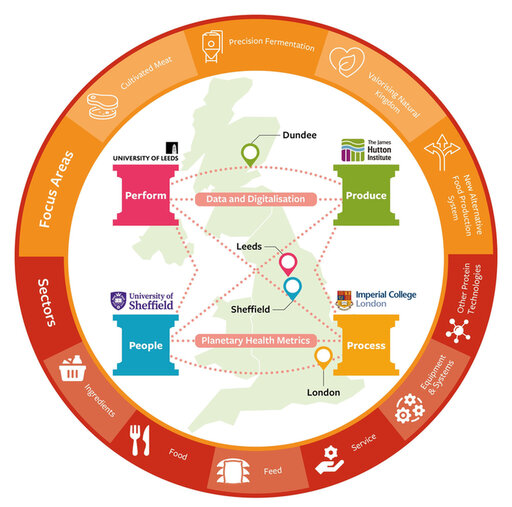Ingredients Focus on
— Column
From Niche to Norm: How NAPIC is Redefining Alternative Proteins
KEYWORDS
Healthy Ageing
Brain Health
Prebiotics
Sarcopenia
Nutrition Science
Collaborative Research
ILSI Federation
USDA/FDA
Alternative protein
Are Alternative Proteins Ready for the Mainstream?
The food landscape is undergoing a profound transformation. As climate imperatives, global food insecurity, diet-associated diseases, and shifting consumer preferences converge, alternative proteins (APs) are evolving from a niche innovation into a structural necessity. However, this transition is neither inevitable nor without challenges. Integrating APs into mainstream diets while ensuring no compromise to taste or texture, nutritional equivalency, affordability, scalability, and environmental sustainability requires a fundamental reconfiguration of food production, distribution, and consumption systems.
The National Alternative Protein Innovation Centre (NAPIC)
NAPIC* is a pioneering initiative set to position the UK as a global leader in alternative protein research and development, innovation, and policy integration. Our vision is to make "alternative proteins mainstream for a sustainable planet," and our ambition is to establish a world-leading innovation and knowledge centre that enhances population health equity and combats climate change (1).
A collaborative powerhouse
NAPIC capitalises on the UK’s world-class interdisciplinary research strengths, led by Imran Afzal, as CEO, food industry veteran, and driven by the academic expertise of four Co-Directors:
- Professor Anwesha Sarkar (Food Material Science, University of Leeds)
- Professor Derek Stewart (Biochemistry, James Hutton Institute)
- Professor Karen Polizzi (Bioengineering, Imperial College London)
- Professor Louise Dye (Psychology, University of Sheffield)
Their expertise spans the UK’s geographical and academic landscape, supported by a collaborative network of over 150 partners across academia, industry, policy makers, regulatory bodies, and investors.
NAPIC is not merely a research and innovation entity; it is a collaborative hub where scientific discovery aligns with market feasibility and consumer acceptance. With a projected £6.8 billion market opportunity and the potential for 25,000 new jobs, NAPIC is shaping an actionable blueprint for transforming the protein economy (2). What sets this initiative apart is a structured, interdisciplinary, science-driven approach that encompasses the entire ecosystem. This means that NAPIC can systematically address and put forward innovative solutions for the barriers preventing AP adoption.

Diagnosing the bottlenecks: Why haven’t Alternative Proteins achieved mass adoption?
While APs offer clear environmental and economic advantages, several entrenched barriers hinder their widespread acceptance:
- Taste and texture expectations – Consumers often perceive APs as inferior to conventional proteins in terms of taste, texture, and overall sensory appeal, limiting repeat purchases.
- Economic and supply chain constraints – High production costs and limited economies of scale create pricing barriers and technological bottlenecks.
- Health and safety perceptions – Misinformation and scepticism regarding the nutritional profile and processing of APs contribute to consumer hesitancy. Additionally, new technologies and modern food production methods can amplify these concerns, whether founded or unfounded. While health and safety regulations exist for most known food-sourced alternative proteins, and novel foods assessment procedures apply to new food sources, satisfying these statutory regulations can be challenging. However, meeting these standards is essential to ensuring that AP products are both safe and nutritionally sound, addressing consumer concerns and fostering trust in emerging food technologies.
- Nutritional equivalence – Animal protein sources are an important dietary source of vitamins (e.g. vitamin A, B2 and B12 and D), minerals (e.g. calcium, iron, zinc, phosphorus and selenium), and new AP food products must deliver nutritional equivalence to support population level healthy diets. Similarly amino acid bioavailability may not be equivalent to animal protein in some AP products. This is particularly critical for certain sections of the population, either at risk of nutrient deficiency or at a time in life where nutrient bioavailability is critical for optimal growth and health. Assuring nutritional equivalence of the UK’s diet as we transition to a lower animal protein diet is essential for population health.
- Implications for the agricultural sector – Concerns over the role of traditional food producers in an AP-integrated food system create resistance within the industry.
- Regulatory and policy complexities – The evolving regulatory landscape and policy ambiguities can slow market entry. However, regulatory oversight is crucial to ensuring APs are safe and do not lead to nutrient deficiencies. Currently, around 45% of the UK population is at risk of nutrient deficiency, highlighting the need for careful planning when reducing reliance on animal proteins.
Innovation at the core
NAPIC aims to support companies in overcoming these challenges through a structured Discovery → Innovation → Commercialisation framework. Rather than dismantling existing structures, NAPIC helps businesses navigate food safety and public health regulations, ensuring that AP products demonstrate nutritional equivalence to the animal-sourced products they replace.
NAPIC also facilitates opportunities for food producers through alternative protein-rich crops, production systems, and training; supports food companies in designing AP foods that are tasty, acceptable, and accessible; and promotes technological solutions that ensure these foods are as healthy as existing animal-sourced alternatives that can be produced at scale sustainably.
Co-designed and prioritised through collaborative workshops, six key innovation challenges (6ICs) have been identified as critical to accelerating industrial adoption (3). Tackling these challenges requires more than just technical breakthroughs—it demands a holistic approach that combines proprietary tools and technologies, specialised training, and access to cutting-edge research facilities.
These insights emerged from our Partner Engagement Workshop (3), where industry leaders, researchers, and policymakers collaborated to shape the future of alternative proteins. The workshop findings provide a roadmap for overcoming adoption barriers and fostering a resilient, sustainable protein economy.
1. PRODUCE: Expanding the viable protein portfolio
NAPIC is pioneering research into novel protein sources, from plant-based proteins and microbial fermentation to insect-derived proteins and algae and other non conventional ways to produce proteins. This pillar aims to enhance the nutritional, functional, and economic viability of these sources while embedding circular bio-economy principles to optimise resource efficiency. Additionally, it prioritises a just transition for traditional food producers, ensuring that AP integration strengthens, rather than undermines, existing agricultural systems.
2. PROCESS: Driving cost-efficient, scalable production
Many APs remain prohibitively expensive for mass adoption. The PROCESS pillar seeks to unlock cost efficienciesthrough precision fermentation, cultivated meat advancements, and AI-optimised production systems. By integrating APs into existing UK manufacturing infrastructures, NAPIC aims to develop a cost-parity roadmap that accelerates affordability and scalability.
3. PERFORM: Optimising consumer experience and health outcomes
Consumer adoption depends not only on accessibility but also on perceived value. NAPIC employsmulti-scale sensory analysis, AI-driven formulation, and human nutritional toolsto enhancetaste, texture, and health benefits. This pillar also critically evaluatesultra-processing concerns and allergenicity, ensuring that APs align with public health objectives and national dietary guidelines (4).
4. PEOPLE: Shaping consumer perception and industry adoption
Behavioural science highlights the importance of familiarity and trust in shaping food choices. The PEOPLEpillar is dedicated to public engagement, consumer education, and industry adoption strategies that normalise AP consumption. It also works closely with policymakers, businesses, and food producers to create inclusive transition pathways that facilitate AP integration without socioeconomic displacement.
NAPIC’s focus extends across a broad spectrum of alternative proteins, including cultivated meat, precision fermentation, and naturally occurring sources (e.g., plants, microbes, waste valorisation, insects, algae, and novel terrestrial and aquatic production systems).
From strategy to systemic change: The National Protein Strategy
NAPIC’s ambitions go beyond research and commercialisation—it is laying the foundations to contribute to a cohesive National Protein Strategy to enhance food security and economic resilience (5), (6), (7). Key objectives include:
- Enhancing domestic food resilience by supporting sustainable protein production and reducing dependence on volatile global meat and dairy supply chains.
- Positioning the UK as a global innovation leader in sustainable protein development.
- Aligning with Net Zero commitments by reducing emissions from traditional livestock agriculture.
- Developing a future-ready workforce equipped with expertise in next-generation AP technologies.
By convening key stakeholders across the ecosystem, NAPIC is shaping a regulatory and market framework that balances public interest mandates with commercial success.
The road ahead: From alternative to mainstream
To accelerate the transition of alternative proteins into the mainstream, NAPIC has launched a series of flagship initiatives. Its Collaborative Programme Funding (CPF) provides £4 million to support research organisations, with £1.5 million awarded in the first year alone. This initiative is designed to address industry-driven challenges and fast-track the adoption of alternative proteins.
NAPIC is also investing in the workforce of the future through targeted CPD courses to tackle industry driven challenges, and supporting innovation via a dedicated incubator for alternative protein ventures.
We invite researchers, industry partners, investors, and policymakers to become NAPIC members and work with us in shaping the future of food. Full details are available at www.napic.ac.uk.
References and notes
* The National Alternative Protein Innovation Centre (NAPIC) is a £38m investment into an Innovation Knowledge Centre (IKC) funded by BBSRC, Innovate UK and national and international partners including academia, industry, regulators, and investors.
- NAPIC www.napic.ac.uk
- Green Alliance, Appetite for change Why the UK should lead the emerging alternative proteins market. Available at: https://green-alliance.org.uk/wp-content/uploads/2023/08/Appetite_for_change.pdf 2023
- Watson, N. & Rafiq, S.,. NAPIC Partner Engagement Workshop Report. 2025 Available at: https://doi.org/10.48785/100/320
- McClements DJ. Ultraprocessed plant-based foods: Designing the next generation of healthy and sustainable alternatives to animal-based foods. Compr Rev Food Sci Food Saf. 2023;22:3531-59.
- (BCG) BCG. The Untapped Climate Opportunity in Alternative Proteins. 2022 Available from: https://www.bcg.com/publications/2022/combating-climate-crisis-with-alternative-protein.
- Commission E-L. Summary report of the EAT-Lancet commission. 2019. Available from: https://eatforum.org/eat-lancet-commission/eat-lancet-commission-summary-report
- Committee TCC. Sixth Carbon Budget: The UK's path to Net Zero. 2000 Available from: https://www.theccc.org.uk/wp-content/uploads/2020/12/The-Sixth-Carbon-Budget-The-UKs-path-to-Net-Zero.pdf.
